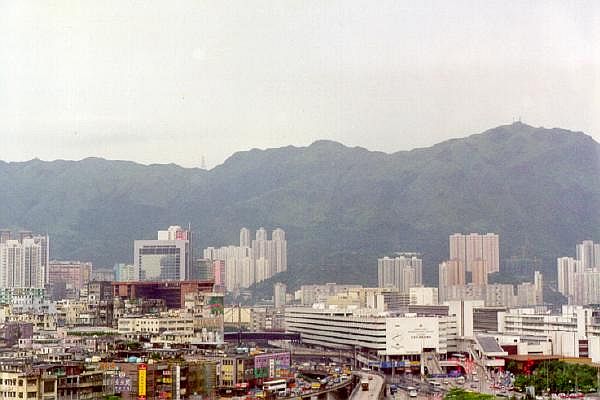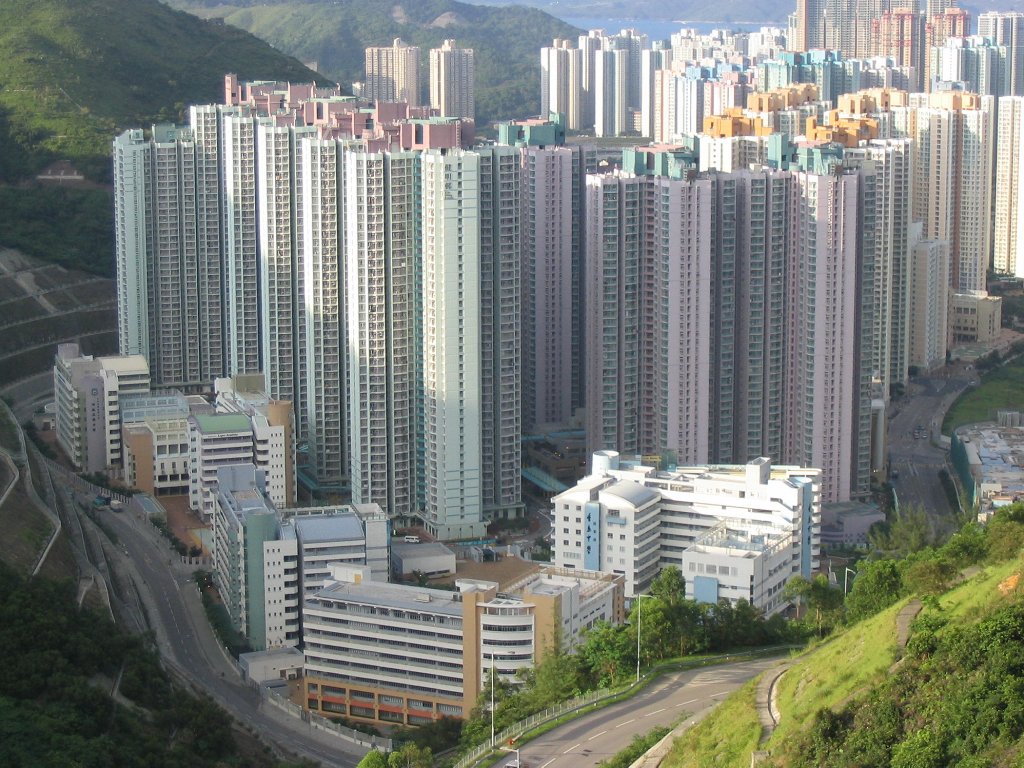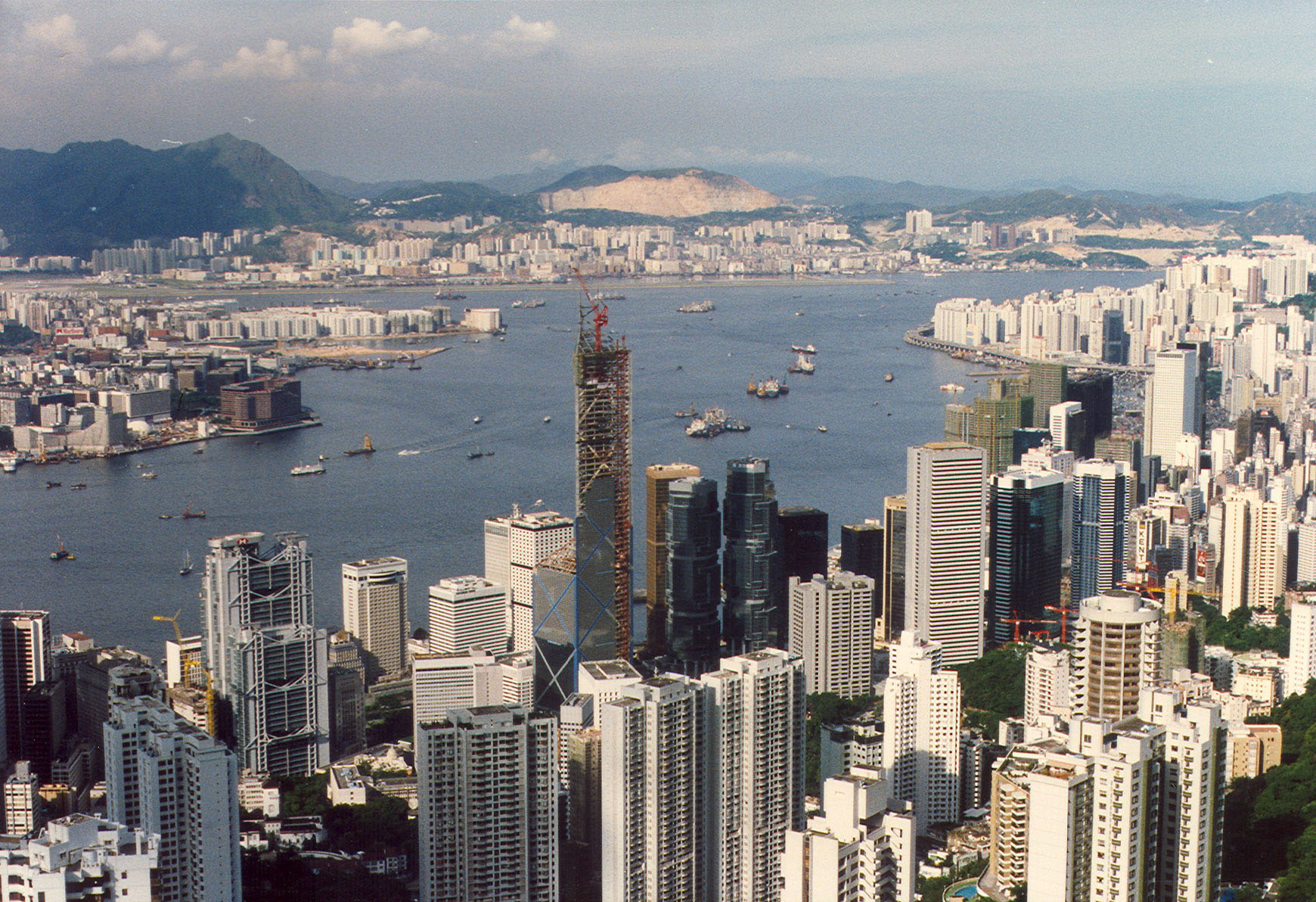|
Skyscrapers In Hong Kong
Hong Kong has over 9,000 high-rise buildings, of which over 4,000 are skyscrapers standing taller than with 517 buildings above . The tallest building in Hong Kong is the 108-storey International Commerce Centre, which stands and is the 12th tallest building in the world. The total built-up height (combined heights) of these skyscrapers is approximately , making Hong Kong the world's tallest urban agglomeration. Furthermore, reflective of the city's high population densities, Hong Kong has more inhabitants living at the 15th floor or higher, and more buildings of at least and height, than any other city in the world. Most of Hong Kong's buildings are concentrated on the northern shore of Hong Kong Island, Kowloon, and the new towns (satellite towns) of the New Territories, such as Tsuen Wan and Sha Tin. Additional high-rises are located along Hong Kong Island's southern shoreline and areas near the stations of the Mass Transit Railway (MTR). The skyline of Hong Kon ... [...More Info...] [...Related Items...] OR: [Wikipedia] [Google] [Baidu] |
Hong Kong Harbour Night 2019-06-11
Hong may refer to: Places *Høng, a town in Denmark *Hong Kong, a city and a special administrative region in China *Hong, Nigeria *Hong River in China and Vietnam *Lake Hong in China Surnames *Hong (Chinese name) *Hong (Korean name) Organizations *Hong (business), general term for a 19th–20th century trading company based in Hong Kong, Macau or Canton *Hongmen (洪門), a Chinese fraternal organization Creatures *Hamsa (bird), a mythical bird also known was hong *Hong (rainbow-dragon), a two-headed dragon in Chinese mythology *Hong (genus), ''Hong'' (genus), a genus of ladybird {{disambiguation ... [...More Info...] [...Related Items...] OR: [Wikipedia] [Google] [Baidu] |
Victoria Harbour
Victoria Harbour is a natural landform harbour in Hong Kong separating Hong Kong Island in the south from the Kowloon Peninsula to the north. The harbour's deep, sheltered waters and strategic location on South China Sea were instrumental in Hong Kong's establishment as a British colony in 1841 and its subsequent development as a trading centre. Throughout its history, the harbour has seen numerous reclamation projects undertaken on both shores, many of which have caused controversy in recent years. Environmental concerns have been expressed about the effects of these expansions, in terms of water quality and loss of natural habitat. It has also been proposed that benefits of land reclamation may be less than the effects of decreased harbour width, affecting the number of vessels passing through the harbour. Nonetheless Victoria Harbour still retains its founding role as a port for thousands of international vessels each year. The harbour is a major tourist attraction of Ho ... [...More Info...] [...Related Items...] OR: [Wikipedia] [Google] [Baidu] |
The Masterpiece (Hong Kong)
The Masterpiece is a 64-floor, 261 metre (856 ft) tall skyscraper in Tsim Sha Tsui, Hong Kong. It houses the six-storey K11 shopping centre in the lower levels and basement. The 381-room Hyatt Regency hotel, located from Level 3 to 24, opened in October 2009. 345 luxury residential apartments"Masterpiece price for flat" , '' The Standard'', September 15, 2009 occupy the 27th to 67th floors with units located on the top floors of the building. The complex is connected to both |
Height Restriction Laws
Height restriction laws are laws that restrict the maximum height of structures. There are a variety of reasons for these measures. Some restrictions limit the height of new buildings so as not to block views of an older work decreed to be an important landmark by a government. For example, in the Russian capital of Saint Petersburg, buildings could not be taller than the Winter Palace. Other restrictions are because of practical concern, such as around airports to prevent any danger to flight safety. Height restriction laws sometimes become a point of contention in cities due to their use in regulating the growth of the housing supply. Fast growth of housing supply benefits renters by producing low prices and more choice, while slow or no growth in housing supply benefits property owners by allowing them to charge higher prices. In this way, height restriction laws often become part of a class conflict even when their original purpose was innocuous. Asia Malaysia Buildings i ... [...More Info...] [...Related Items...] OR: [Wikipedia] [Google] [Baidu] |
Kai Tak Airport
Kai Tak Airport was the international airport of Hong Kong from 1925 until 1998. Officially known as Hong Kong International Airport from 1954 to 6 July 1998, it is often referred to as Hong Kong International Airport, Kai Tak, or simply Kai Tak and Kai Tak International Airport, to distinguish it from its successor, Chek Lap Kok International Airport, built on reclaimed and levelled land around the islands of Chek Lap Kok and Lam Chau, to the west. Because of the geography of the area positioning the airport with water on three sides of the runway, with Kowloon City's residential apartment complexes and 2000-plus foot mountains to the north-east of the airport, aircraft could not fly over the mountains and quickly drop in for a final approach. Instead, aircraft had to fly above Victoria Harbour and Kowloon City, passing north of Mong Kok's Bishop Hill. After passing Bishop Hill, pilots would see Checkerboard Hill with a large red and white checkerboard pattern. Once t ... [...More Info...] [...Related Items...] OR: [Wikipedia] [Google] [Baidu] |
Public Housing In Hong Kong
Public housing in Hong Kong is a set of mass housing programmes through which the Government of Hong Kong provides affordable housing for lower-income residents. It is a major component of housing in Hong Kong, with nearly half of the population now residing in some form of public housing. The public housing policy dates to 1954, after a fire in Shek Kip Mei destroyed thousands of shanty homes and prompted the government to begin constructing homes for the poor. Public housing is mainly built by the Hong Kong Housing Authority and the Hong Kong Housing Society. Rents and prices are significantly lower than those for private housing and are heavily subsidised by the government, with revenues partially recovered from sources such as rents and charges collected from car parks and shops within or near the residences. Many public housing estates are built in the new towns of the New Territories, but urban expansion has left some older estates deep in central urban areas. Th ... [...More Info...] [...Related Items...] OR: [Wikipedia] [Google] [Baidu] |
One Island East
One Island East is a skyscraper in Taikoo Place, Quarry Bay, Hong Kong Island, Hong Kong. Overview The skyscraper is a commercial office building, rising 298.35 m (979 ft) and has 69 storeys plus two levels of basement. There is a sky lobby on the 37th and 38th floors. In addition, there are 28 high-speed passenger lifts, six high-speed shuttle lifts between Main (G - 1/F) and Sky (37 - 38/F) lobbies, one passenger lift between the main lobby and basement carpark and two service lifts. One Island East was built under the first use of the Land (Compulsory Sale for Redevelopment) Ordinance (Cap 545), exercised by Swire in 2000. Part of the site was previously occupied by Melbourne Industrial Building (23-floor industrial building demolished 2005) and Aik San Factory Building (22-floor industrial building demolished 2005) which were acquired by the developer in 2002 and 2001 respectively. The main contractor was Gammon Construction. Tenants The head office of the ... [...More Info...] [...Related Items...] OR: [Wikipedia] [Google] [Baidu] |
Nina Tower
Nina Tower is a twin tower of 80-storey and 42-storey high-rise buildings in Tsuen Wan, New Territories, Hong Kong near Tsuen Wan West station. The tower was designed to be the tallest tower in the world at . However, due to its location near Chek Lap Kok Airport, the height was restricted to the current . The owner of Chinachem Group later changed her plan and broke it into two towers. The lower is known as Nina Tower, symbolising the late Nina Wang or Kung Yu Sum natively, the owner of Chinachem Group; the higher is Teddy Tower, symbolising her husband Teddy Wang, who was kidnapped and has since disappeared. Despite the different tower names, the whole development is called Nina Tower. The complex is home to a 1608-room premium hotel, Nina Hotel Tsuen Wan West, office space, shopping mall and convention & event space. Sky Lobby is located at the 41st floor which connects the 2 towers. The head office of Chinachem Group and Nina Hospitality Company Limited are located ... [...More Info...] [...Related Items...] OR: [Wikipedia] [Google] [Baidu] |
Two International Finance Centre
2 (two) is a number, numeral and digit. It is the natural number following 1 and preceding 3. It is the smallest and only even prime number. Because it forms the basis of a duality, it has religious and spiritual significance in many cultures. Evolution Arabic digit The digit used in the modern Western world to represent the number 2 traces its roots back to the Indic Brahmic script, where "2" was written as two horizontal lines. The modern Chinese and Japanese languages (and Korean Hanja) still use this method. The Gupta script rotated the two lines 45 degrees, making them diagonal. The top line was sometimes also shortened and had its bottom end curve towards the center of the bottom line. In the Nagari script, the top line was written more like a curve connecting to the bottom line. In the Arabic Ghubar writing, the bottom line was completely vertical, and the digit looked like a dotless closing question mark. Restoring the bottom line to its original horizonta ... [...More Info...] [...Related Items...] OR: [Wikipedia] [Google] [Baidu] |
Central Plaza (Hong Kong)
Central Plaza is a 78-storey, skyscraper completed in August 1992 at 18 Harbour Road, in Wan Chai on Hong Kong Island in Hong Kong. It is the third tallest tower in the city after 2 International Finance Centre in Central and the ICC in West Kowloon. It was the tallest building in Asia from 1992 to 1996, until the Shun Hing Square was built in Shenzhen, a neighbouring city. Central Plaza surpassed the Bank of China Tower as the tallest building in Hong Kong until the completion of 2 IFC. Central Plaza was also the tallest reinforced concrete building in the world, until it was surpassed by CITIC Plaza, Guangzhou. The building uses a triangular floor plan. On the top of the tower is a four-bar neon clock that indicates the time by displaying different colours for 15-minute periods, blinking at the change of the quarter. An anemometer is installed on the tip of the building's mast, at above sea level. The mast has a height of . It also houses the world's highest church ... [...More Info...] [...Related Items...] OR: [Wikipedia] [Google] [Baidu] |
Bank Of China Tower (Hong Kong)
The Bank of China Tower (BOC Tower) is a skyscraper located in Central, Hong Kong. Located at 1 Garden Road on Hong Kong Island, the tower houses the headquarters of the Bank of China (Hong Kong) Limited. One of the most recognisable landmarks in Hong Kong, the building is notable for its distinct shape and design, consisting of triangular frameworks covered by glass curtain walls. The building was designed by Chinese-American architect I. M. Pei and L.C Pei of I.M Pei and Partners. At a height of , reaching high including a spire, the building is the fourth tallest skyscraper in Hong Kong, after International Commerce Centre, Two International Finance Centre and Central Plaza. It was the tallest building in Hong Kong and Asia from 1989 to 1992, and it was the first supertall skyscraper outside the United States, the first to break the 305 m (1,000 ft) mark. It was surpassed by Central Plaza on the same island in 1992. Construction began on 18 April 1985 o ... [...More Info...] [...Related Items...] OR: [Wikipedia] [Google] [Baidu] |
Hopewell Centre (Hong Kong)
Hopewell Centre is a , 64-storey skyscraper at 183 Queen's Road East, in Wan Chai, Hong Kong Island in Hong Kong. The tower is the first circular skyscraper in Hong Kong. It is named after Hong Kong–listed property firm Hopewell Holdings Limited, which constructed the building. Hopewell Holdings Limited's headquarters are in the building and its chief executive officer, Gordon Wu, has his office on the top floor. Description Construction started in 1977 and was completed in 1980. Upon completion, Hopewell Centre surpassed Jardine House as Hong Kong's tallest building. It was also the second tallest building in Asia at the time. It kept its title in Hong Kong until 1989, when the Bank of China Tower was completed. The building is now the 20th tallest building in Hong Kong. The building has a circular floor plan. Although the front entrance is on the 'ground floor', commuters are taken through a set of escalators to the 3rd floor lift lobby. Hopewell Centre stands on the s ... [...More Info...] [...Related Items...] OR: [Wikipedia] [Google] [Baidu] |





